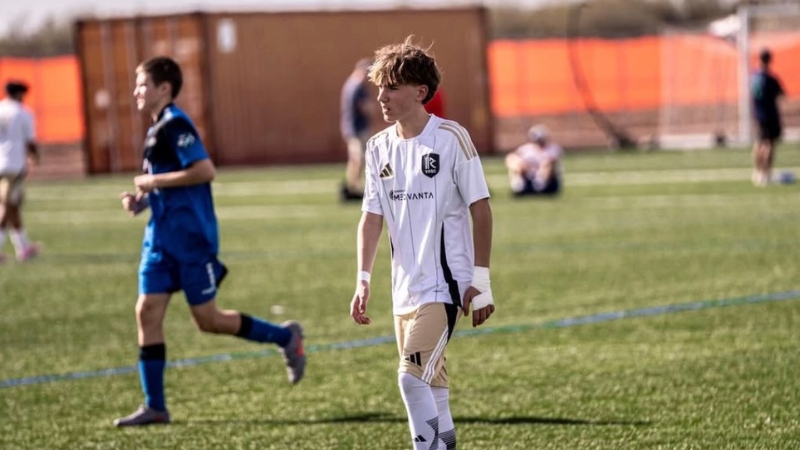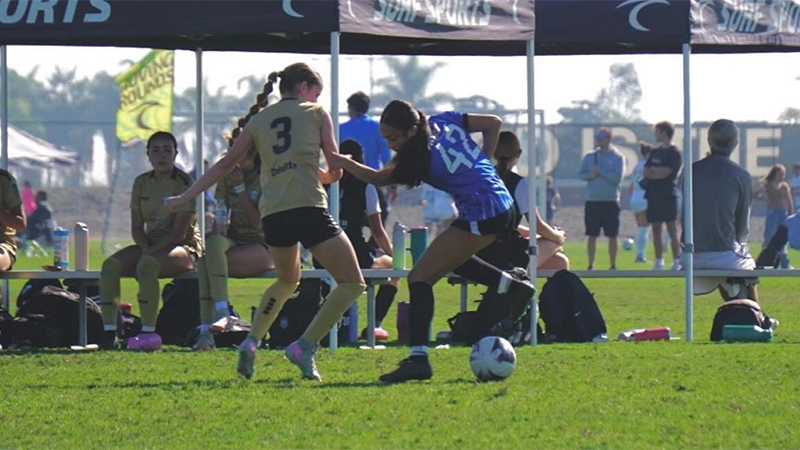Frustration with California’s shutdown

The faint paint lines are there if you stare closely. The goals are there, but they are pushed together and bound to be stuck together under lock and key. The massive grass expanse of California soccer fields mostly sit empty during the weekends.
In the reality of the new world during the time of a global pandemic, California’s approach has been wait and see. The deliberate patience is creating a massive gap between the state and the rest of the country in the world of youth sports.
With more than 300,000 registered youth and adult soccer players, California has one of the largest player pools of any state in the country. It is also one of only a few states that has not allowed teams to return to competition since the shutdown eight months ago.
The long-term hiatus has created frustration from coaches, parents, and players. The annoyance has been compounded by other states returning to play over the last few months.
“What was frustrating was not to be able to do the thing I love most,” Mia Parkhurst, a high school senior from Northern California, told TopDrawerSoccer. “But my frustration was never directed toward my club or my coach.”
Parkhurst explained that the shutdown due to COVID was not the only reason that she looked at her options. Wildfires ravaged large parts of the state and created unhealthy air quality that kept teams from training as well.
Stuck at home, Parkhurst and her family looked at her options. She had already made her verbal commitment to Georgia, and contemplated possibly heading to the Southeast sooner rather than later.
“The idea really came about as a discussion as a family,” Parkhurst said. “My future college coach did mention his concern that I wasn't playing, but he knew there wasn't really anything I could do about it. But when my dad mentioned our concern about not playing to my future teammate's dad, that's when the idea really started to get more serious.”
Parkhurst flew to Georgia earlier this month and began training with her new club team, United Futbol Academy (UFA). She is going to live with her future roommate’s family while playing for the ECNL club. She is not alone in the players departing from the state that used to be viewed as the gold standard for youth soccer.
FC Dallas ECNL coach Aaron Gordon told TopDrawerSoccer that his club has been fielding calls from players and parents nearly weekly with players desperate to join his 2004 team, which was a national semifinalist in 2019.
Gordon’s team did pick up an addition from the calls. Sydney Japic, one of the top 2004 defenders from California, is joining FC Dallas. A couple of kids from California are joining other teams at FC Dallas as well.
Gordon said that some families have relocated to Texas, thanks to the availability to work-from-home, so their daughters could play for the club. FC Dallas is not advertising for players to join the club, and Japic was a rare exception as a player with international pedigree who could crack the lineup for the team. The vast majority of players who call FC Dallas are turned away.
FC Dallas and UFA are picking up players thanks to unusual circumstances, residency academies like IMG Academy (Florida) and Barça Residency Academy (Arizona) are experiencing a large increase in interest from California players/families.
“IMG Academy has had significant interest in our soccer program from California players and their families,” IMG Academy Director of Soccer Don Cameron told TopDrawerSoccer. “We have seen an increase in enrollments on both the boys and girls sides of our program.”
Barça Residency Academy has experienced a similar increase in curiosity from players looking to join the Academy. Adding to the club's pull is the plethora of professional players produced recently, such as Caden Clark (New York Red Bulls), Julian Araujo (LA Galaxy), Bryce Duke (LAFC), and Matthew Hoppe (FC Schalke 04).
“We have definitely seen a lot of interest coming from California based players,” Barça Residency Academy USA Director of Soccer Operations Miha Kline told TopDrawerSoccer. “It's one of our biggest markets but we've seen an even larger uptick of players reaching out trying to find a top quality option for this 2020-21 season due to the COVID-19 situation and restrictions in their state(s). We are fortunate to have a full time residential program and have been able to implement a very strict and detailed safety protocol on campus in order to maintain a safe and closed environment for our players and staff.”
Kline said teams from California have been reaching out too. They are looking for an opportunity to play a game with competition shut down in the Golden State.
Brian Enge, the CEO of Surf Cup Sports, told the San Diego Union Tribune that 80 percent of Surf Soccer Club players, one of the biggest youth sports organizations in the country, have already made a trip to Arizona this summer or fall. It is a two and a half hour drive to the Arizona border, and a five-hour drive to Phoenix from San Diego.
While Southern California teams have traveled to Arizona, Northern California teams have eyed Nevada and Oregon.
CBS 13, a Sacramento affiliate, reported that 90% of parents from a Placer County club supported traveling out of the state for games. Placer is two and a half hours from Reno, Nevada. CBS13 cited a need from the parents to get their players back on the field in hopes of helping with college recruiting.
TopDrawerSoccer spoke with a handful of players about leaving the state, and some talked about the worry of falling behind their peers from other states.
“I was most frustrated when I knew the majority of athletes had opportunities to come back and play,” Parkhurst told TopDrawerSoccer about her decision to leave the state and head to Georgia. “I just felt like every day I was losing ground.”
Many also talked about being frustrated about losing the sense of camaraderie that comes with being part of a team that is competing for something. The University of Wisconsin published a study in August regarding the effects of shutting down high school and youth sports for mental health.
“Fundamentally, increased access to sports creates better health outcomes - mentally, physically, and emotionally - for our children,” Dr. Drew Watson, one of the researchers for the study and the ECNL’s Chief Medical Advisor, wrote about the results of the study.
Leaving the state is not an option for everyone, and even traveling hundred of miles every weekend is a stretch - and frankly not a recommended path for the benefit of the community.
Silicon Valley Soccer Academy Technical Director Gerson Perez told TopDrawerSoccer that he met with local health officials to discuss options for his teams.
“We have met with local health department members and [traveling out of the county/state] is not an encouraged endeavor and we have been told to find alternative ways,” Perez told TopDrawerSoccer.
He expressed that his top priority is the safety of his players and families, but shared in the disappointment of not being able to compete or even train given the current limitations placed on youth sports in California.
“Our players have not even played a 5v5 since March,” Perez said. “They have not played a possession exercise with pressure. As coaches, we are having a hard time coaching decision-making since no pressure can be applied inside six feet. This, in my opinion, can really affect how our players will compare with the rest of the country and what will be those effects in the next two-three years.”
Perez said players from his club have left the state and joined clubs in Colorado and Utah since the shutdown, both states that returned to play and are in the midst of their fall seasons.
The growing resentment has only been compounded with a study released that showed the transmission rate was extremely low in outdoor sports like soccer. The same group from the University of Wisconsin released that second study last month. They surveyed 90,000 players from various clubs across the country and showed only one case of COVID-19 transmission at a youth soccer club.
For California families and clubs looking for answers on when they will return to the field, they have been met with a roundabout of non-answers.
The San Diego Union-Tribune reported that the California Department of Public Health would provide more clarity on youth sports returning last week. The deadline passed and there was no official statement.
“We are taking a slow and stringent approach to protect the health of all Californians during the pandemic,” a CDPH spokesperson told CBS13. “This is important as well with flu season right around the corner.”
The reality is that families and players who can afford to leave the state of California can and will so they don’t fall behind the competition. However, Perez talked about how many of the players from his club come from working families and they don’t have the luxury or means to get up and leave the state for youth sports.
“The families that can afford to do so definitely have an advantage as they have been playing games for three months now,” Perez said. “Our players, for the most part, cannot afford to leave the state. [They] continue to train in our program … a lot of our families work in manual labor, hospitality or an industry that cannot be done remotely.”
This gap between the players and teams with means to continue playing and those who are forced to stay off the field is driving a wedge in the sport as a whole - COVID is not the cause of the wedge, but it’s going to do its part in furthering the gap. Participation in soccer is down overall in recent years as a study published in 2018 revealed that youth participation in the sport was down nearly 14 percent.
Part of the explanation for the decrease in participation is the rising costs in the sport from travel. The average household income for the majority of families involved in youth soccer is over $100,000. Soccer also has the lowest participation rate for families with an income under $20,000, among the four sports surveyed by the Sports and Fitness Industry Association in 2017.
Shutting down the sport in California, which has hundred of thousands of participants and a wide variety of income levels between clubs and players, is increasing the gap between the haves and have nots, which could have consequences for years.
California’s slow and stringent approach to the return of youth sports is creating a great exodus, but the players left behind are being punished the most.
Headlines
- Recruiting Roundup: January 5-11
- Professional Signing Tracker: 2025-26
- Tracking Division I Coaching Changes
- 2026 Women's Division I Transfer Tracker
-
ECNL Boys FL: Under-19 Standouts

-
Ten MLS Next AD U15 Players to Know

-
ECNL Girls FL: Under-19 Players to Watch

-
Commitments: Valuing Virginia Tech

- ECNL Girls FL: Selection Game Rosters
-
Ten MLS Next AD U14 Players to Know




